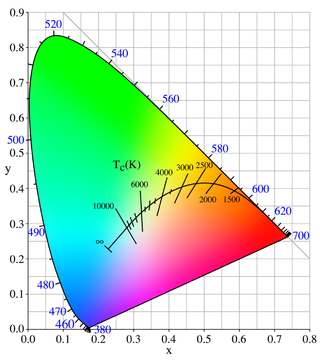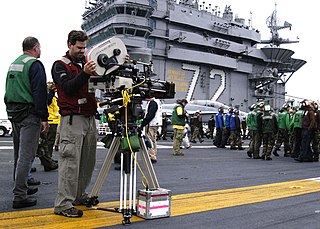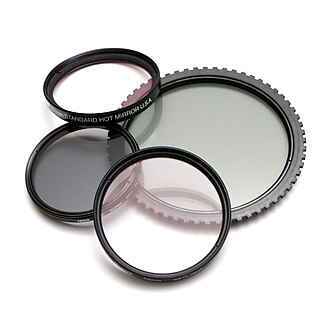Related Research Articles

Color temperature is a parameter describing the color of a visible light source by comparing it to the color of light emitted by an idealized opaque, non-reflective body. The temperature of the ideal emitter that matches the color most closely is defined as the color temperature of the original visible light source. The color temperature scale describes only the color of light emitted by a light source, which may actually be at a different temperature.

The cinematographer or director of photography is the person responsible for the recording of a film, television production, music video or other live-action piece. The cinematographer is the chief of the camera and light crews working on such projects. They would normally be responsible for making artistic and technical decisions related to the image and for selecting the camera, film stock, lenses, filters, etc. The study and practice of this field are referred to as cinematography.

Cinematography is the art of motion picture photography.

A color gel or color filter, also known as lighting gel or simply gel, is a transparent colored material that is used in theater, event production, photography, videography and cinematography to color light and for color correction. Modern gels are thin sheets of polycarbonate, polyester or other heat-resistant plastics, placed in front of a lighting fixture in the path of the beam.

In photography and cinematography, a filter is a camera accessory consisting of an optical filter that can be inserted into the optical path. The filter can be of a square or oblong shape and mounted in a holder accessory, or, more commonly, a glass or plastic disk in a metal or plastic ring frame, which can be screwed into the front of or clipped onto the camera lens.

Congo red is an organic compound, the sodium salt of 3,3′-([1,1′-biphenyl]-4,4′-diyl)bis(4-aminonaphthalene-1-sulfonic acid). It is an azo dye. Congo red is water-soluble, yielding a red colloidal solution; its solubility is greater in organic solvents. The use of Congo red in the textile industry has long been abandoned, primarily because of its carcinogenic properties, but it is still used for histological staining.

Gilbert Taylor, B.S.C. was a British cinematographer, best known for his work on films such as Dr. Strangelove, A Hard Day's Night, Repulsion (1965), The Omen (1976), and Star Wars (1977). In the course of his career, he collaborated with directors like Roman Polanski, Stanley Kubrick, Alfred Hitchcock, and Mike Hodges. He was nominated for two BAFTA Awards, and received a Lifetime Achievement Award from the British Society of Cinematographers.

Kinemacolor was the first successful colour motion picture process. Used commercially from 1909 to 1915, it was invented by George Albert Smith in 1906. It was a two-colour additive colour process, photographing a black-and-white film behind alternating red/orange and blue/green filters and projecting them through red and green filters. It was demonstrated several times in 1908 and first shown to the public in 1909. From 1909 on, the process was known and trademarked as Kinemacolor and was marketed by Charles Urban’s Natural Color Kinematograph Company, which sold Kinemacolor licences around the world.

Panavision is an American motion picture equipment company founded in 1954 specializing in cameras and lenses, based in Woodland Hills, California. Formed by Robert Gottschalk as a small partnership to create anamorphic projection lenses during the widescreen boom in the 1950s, Panavision expanded its product lines to meet the demands of modern filmmakers. The company introduced its first products in 1954. Originally a provider of CinemaScope accessories, the company's line of anamorphic widescreen lenses soon became the industry leader. In 1972, Panavision helped revolutionize filmmaking with the lightweight Panaflex 35 mm movie camera. The company has introduced other cameras such as the Millennium XL (1999) and the digital video Genesis (2004).

Frederick William FrancisBSC was an English cinematographer and film director whose filmmaking career spanned over 60 years, from the late 1930s until the late 2000s. One of the most celebrated British cinematographers of his time, he received numerous accolades for his photography, including two Academy Awards and five BAFTA Awards. As a director he was best known for his horror films, notably those made for production companies Amicus and Hammer in the 1960s and 1970s.
Christopher George Joseph Challis BSC, FRPS was a British cinematographer who worked on more than 70 feature films from the 1940s onwards.
In optics, a diffuser is any material that diffuses or scatters light in some manner to transmit soft light. Diffused light can be easily obtained by reflecting light from a white surface, while more compact diffusers may use translucent material, including ground glass, teflon, opal glass, and greyed glass.
A colour scroller or colour changer is an electro-mechanical lighting accessory used in theater, film, dance and concerts to change the colour projected by stage lighting instruments without the need of a person to be in the vicinity of the light. A colour scroller moves plastic "gel" colour gel [actually dyed polyester and/or other base materials coated with dyes] into the beam of the light. It is generally attached to the gel frame holder at the transmitting end of a lighting fixture, so colour is introduced after the beam characteristics have been defined by the optics of the lighting instrument. Most scrollers are controlled via DMX512 protocol, but some models also utilize the RDM protocol. When colour scrollers were first introduced around 1980, a number of companies produced them, including: Avolites, GAM Products, Morpheus Lights, Rainbow, Rosco Laboratories and Wybron Inc. Now the main manufacturers are: A.C. Lighting, Apollo, Morpheus Lights and Rainbow.

Anamorphic format is the cinematography technique of shooting a widescreen picture on standard 35 mm film or other visual recording media with a non-widescreen native aspect ratio. It also refers to the projection format in which a distorted image is "stretched" by an anamorphic projection lens to recreate the original aspect ratio on the viewing screen. The word anamorphic and its derivatives stem from the Greek anamorphoo, compound of morphé with the prefix aná.
Oswald Norman Morris, BSC was a British cinematographer. Known to his colleagues by the nicknames "Os" or "Ossie", Morris's career in cinematography spanned six decades.
Lee Electric (Lighting) Ltd was incorporated as a business in 1961 by John and Benny Lee, two film lighting electricians. Lee Electric was primarily involved in the rental of lighting equipment for commercial and documentary productions, as all principal film and television studios were at the time equipped with their own lighting equipment.
Articles related to the field of motion pictures include:
Richard Moore was an American cinematographer. In 1953, Moore teamed with Robert Gottschalk to co-found Panavision.
Robert McLachlan is a Canadian cinematographer. A successful cyclist in his youth, McLachlan quit the sport to take up cinematography, and entered the field after studying at Simon Fraser University, McLachlan was mentored by Richard Leiterman. His professional career began with documentary work for Greenpeace, before he became involved in both television and feature films; his work has subsequently earned him several industry awards and award nominations.
Masanobu "Masa" Takayanagi is a Japanese cinematographer whose works include Silver Linings Playbook (2012), Warrior (2011) and The Grey (2011).
References
- ↑ "LEE FILTERS | Panavision". Archived from the original on 11 April 2013. Retrieved 10 March 2013.
- ↑ "Awards | British Society of Cinematographers".